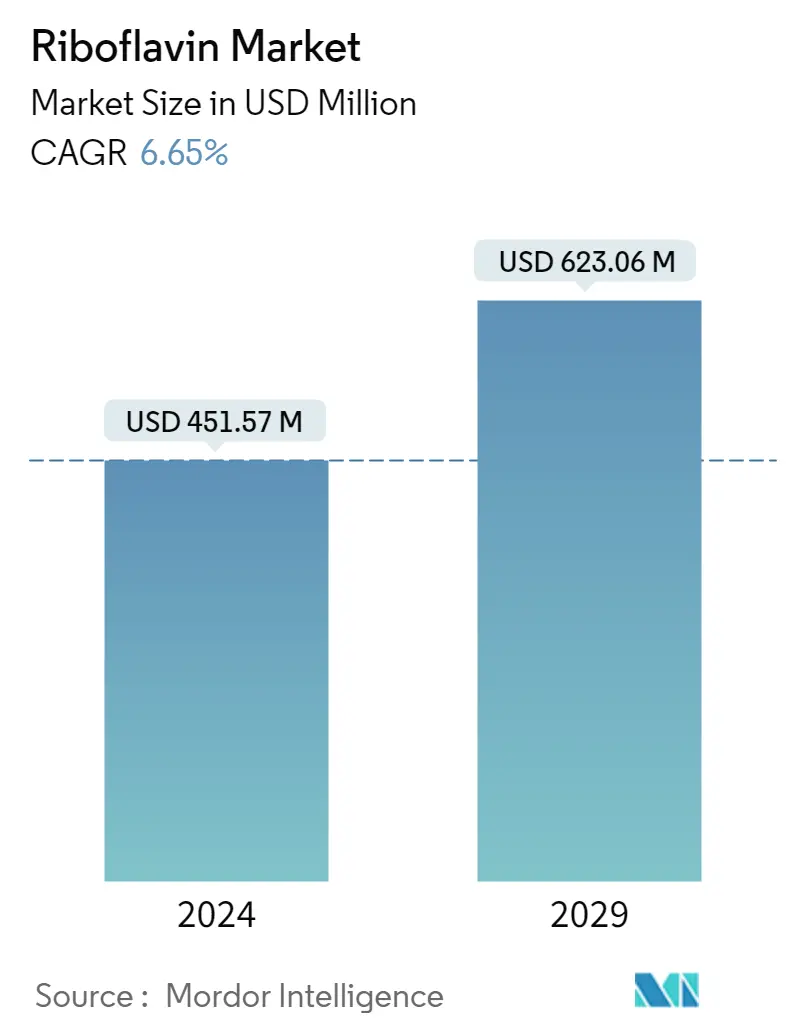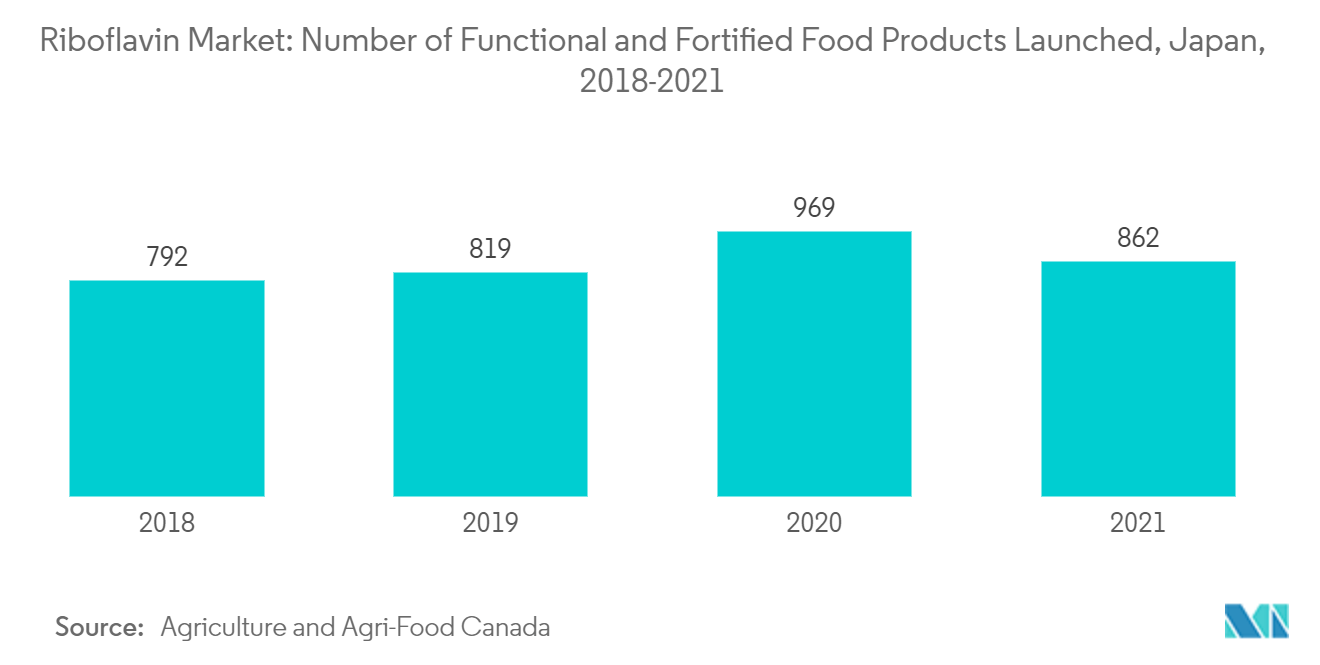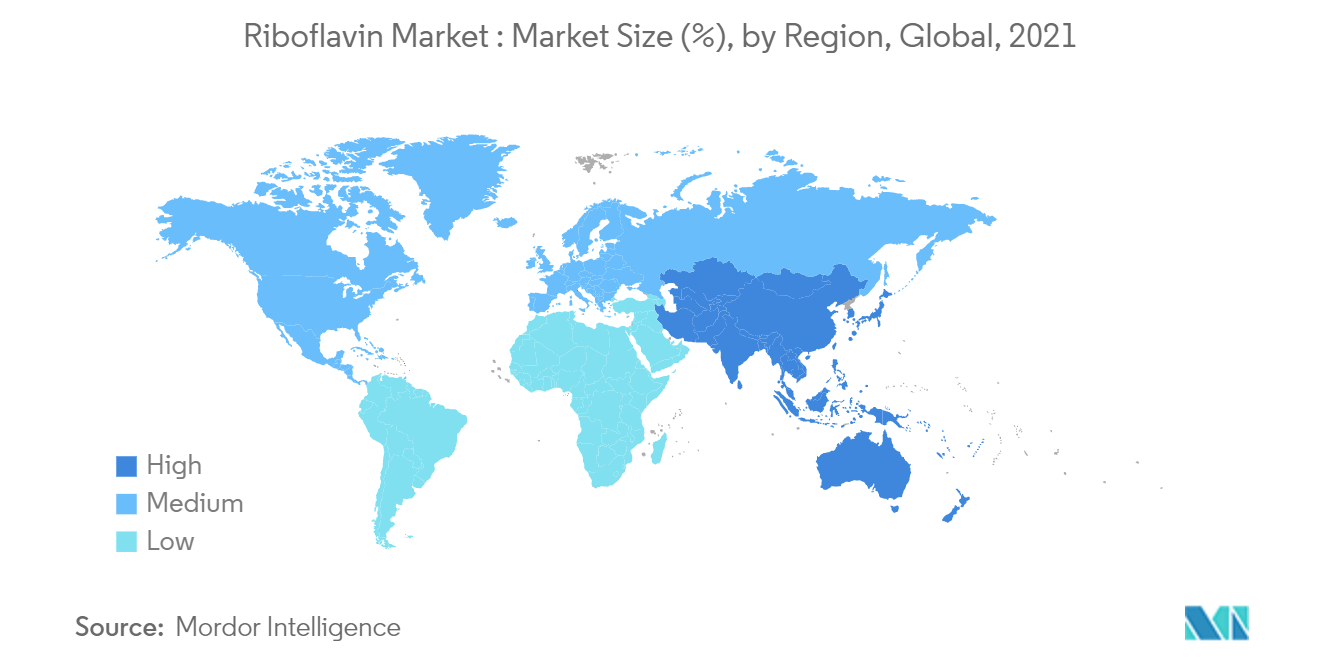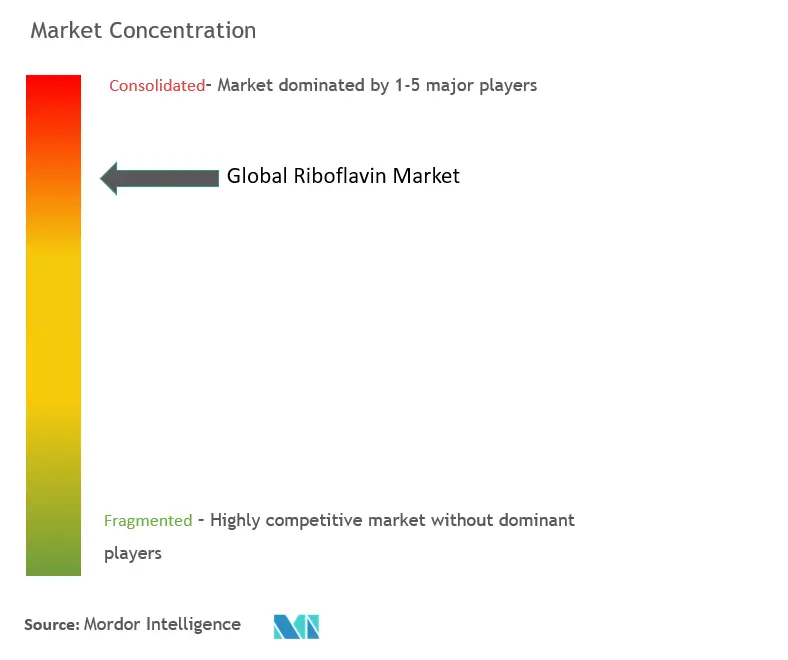Riboflavin Market Size

| Study Period | 2019 - 2029 |
| Market Size (2024) | USD 451.57 Million |
| Market Size (2029) | USD 623.06 Million |
| CAGR (2024 - 2029) | 6.65 % |
| Fastest Growing Market | Asia Pacific |
| Largest Market | Asia-Pacific |
| Market Concentration | Low |
Major Players.webp)
*Disclaimer: Major Players sorted in no particular order |
Riboflavin Market Analysis
The Riboflavin Market size is estimated at USD 451.57 million in 2024, and is expected to reach USD 623.06 million by 2029, growing at a CAGR of 6.65% during the forecast period (2024-2029).
It is expected that the riboflavin market will continue to grow due to an increase in the global consumption of fortified foods and beverages. According to the Food Fortification Initiative, it is estimated that close to 31% of the industrially milled wheat flour in the world is fortified. There are primarily iron, zinc, folic acid, riboflavin, niacin, thiamin, vitamin B12, and vitamin B6 added to foods and beverages. Furthermore, riboflavin is expected to grow in popularity because of its broad application and multi-functionality. Riboflavin/vitamin B2 has diverse applications in many fields, including food processing, pharmaceuticals, and animal feeding, which is further fostering the demand in the market.
The riboflavin market is driven by the increased demand for riboflavin-infused supplements, owing to its multi-utility, which makes it extremely useful in all sectors of the market across the world. The growing use of natural colorants in the packed food industry and the dietary supplements industry is driving the demand for riboflavin in the global market. The prevalence of vitamin deficiency in typical Western diets is higher, especially in senior adults. Milk and milk products fortified with Vitamin B2 are critical in the North American fortified foods market and are likely to fuel the overall need.
Riboflavin Market Trends
Increasing Demand for Functional and Fortified Food
- In the past, food fortification has been used to prevent micronutrient malnutrition. But today, food fortification is used to improve health and wellness. By increasing baked food's better-for-you attributes, fortification provides avenues for manufacturers to add value to their product categories.
- For instance, according to the Food Fortification Initiative (FFI), a global organization that supports the fortification of industrially milled flour, maize flour, and rice, approximately 31% of the world's industrially milled wheat flour is fortified. The FFI works with country leaders to promote, plan, implement, and monitor the fortification process to improve the nutritional quality of these staple foods.
- Various government initiatives are being taken to increase the consumption of fortified food and beverages, especially in developing countries. Similarly, the Food and Agricultural Organization (FAO) and World Health Organization (WHO) have identified food fortification as one of the strategies to reduce the prevalence of malnutrition, particularly in underdeveloped and developed countries.
- The nutrients most often included are iron, zinc, and the following B vitamins, namely folic acid, niacin, riboflavin, thiamin, vitamin B12, and vitamin B6. Thus, with the increasing consumer demand for fortified food and beverages with bioactive and essential vitamins, followed by increasing consumer awareness regarding vitamin B2/riboflavin deficiency, the manufacturers are actively expanding their product offerings with the fortification of riboflavin to meet the ongoing consumer demand.
- In October 2022, Fonterra expanded its product portfolio with the launch of BioKodeLab, a supplement brand aimed at improving cognitive performance. According to the company, the product consists of vitamin A, riboflavin, lutein, and zeaxanthin to support macular health.
- .

Asia-Pacific to Drive the Global Market For Riboflavin
- Asia-Pacific holds the dominant position in the riboflavin market, driven by factors such as rapid urbanization, industrialization, ongoing product development, and technological advancements in the region. Moreover, increasing health awareness among people, the rise in per-capita income, and a wide range of applications have been further augmenting the market growth.
- For instance, according to World Bank, gross domestic product (GDP) per capita in Singapore, Australia, and Japan was USD 72,794, 59,594, and 39,285, respectively, in 2021. Some of the popular riboflavin sources in the region encompass meat, eggs, salmon, and dairy products.
- However, with the growing consumer preferences toward veganism/vegetarianism across the region, there has been rising pressure on the food ingredients manufacturers, like BASF SE, MTC Industries Inc., and DSM, to invest in research and development and introduce plant-based riboflavin ingredients for multiple industrial applications such as food and beverages, personal care products, nutraceuticals, pharmaceuticals, and animal feed.
- As cereals are inexpensive and consumed in large quantities in the country for producing multiple food products like porridge, breakfast cereals, raised bread, flatbread, biscuits, cereal-based beverages, and seedling juices, attempts are being made to enrich these cereal grains and flour with vitamins B1, B2, B3, and B9 using fortification and biofortification, as recommended by the Food & Drug Administration (FDA).
- Additionally, riboflavin deficiency is a problem in many parts of Asia and the Pacific, especially in South and Southeast Asia. In response, governments and health organizations have launched fortification programs to increase the nutritious density of commonly consumed foods like rice, flour, and oil by adding vitamins and minerals like riboflavin. Fortification initiatives are driving riboflavin demand in the region.

Riboflavin Industry Overview
The global riboflavin market is concentrated in nature due to many regional and domestic players. Importance is given to partnerships, expansions, product innovations, and mergers and acquisitions as leading companies adopt strategic approaches to boost their brand presence among consumers.
Consumers in the market are increasingly becoming health conscious and looking for health supplements. This factor strategically makes companies innovate and expand their existing product portfolios, thereby making the market more conducive to further development to gain more revenue.
Some major players in the market studied include BASF SE, Hubei Guangji Pharmaceutical Co. Ltd, Xinfa Pharmaceutical Co. Ltd, Koninklijke DSM NV, and Shanghai Acebright Pharmaceuticals Group Co. Ltd, among others.
Riboflavin Market Leaders
-
BASF SE
-
Hubei Guangji Pharmaceutical Co. Ltd.
-
Koninklijke DSM NV ​
-
Shanghai Acebright Pharmaceuticals Group Co. Ltd​.
-
Xinfa Pharmaceutical Co. Ltd​.
*Disclaimer: Major Players sorted in no particular order

Riboflavin Market News
- May 2023: DSM-Firmenich AG, the global innovation partner in nutrition, health, and beauty, completed its merger with Firmenich International SA.
- May 2022: Royal DSM agreed to merge with Firmenich. DSM-Firmenich will have four business units - perfumery and beauty, food and beverage, health and nutrition, and animal nutrition, with combined sales of approximately EUR 11.5 billion (USD 13.58 billion).
- December 2021: According to a study conducted by Kobe University, the addition of vitamin B2 to cells exposed to aging stress has been found to enhance the mitochondria's ability to produce energy, effectively preventing cell aging.
Riboflavin Market Report - Table of Contents
1. INTRODUCTION
1.1 Study Assumptions and Market Definition
1.2 Scope of the Study
2. RESEARCH METHODOLOGY
3. EXECUTIVE SUMMARY
4. MARKET DYNAMICS
4.1 Drivers
4.1.1 Increasing Demand for Functional and Fortified Food
4.1.2 Multi-functionality and Wide Application of Riboflavin
4.2 Restraints
4.2.1 Low Stability of Riboflavin on Exposure to Light and Heat
4.3 Industry Attractiveness-Porter's Five Forces Analysis
4.3.1 Bargaining Power of Suppliers
4.3.2 Bargaining Power of Buyers
4.3.3 Threat of New Entrants
4.3.4 Threat of Substitutes
4.3.5 Intensity of Competitive Rivalry
5. MARKET SEGMENTATION
5.1 Form
5.1.1 Powder
5.1.2 Liquid
5.2 Application
5.2.1 Food and Beverages
5.2.2 Dietary Suppplements
5.2.3 Pharmaceuticals
5.2.4 Animal Feed
5.2.5 Personal Care
5.2.6 Other Applications
5.3 Geography
5.3.1 North America
5.3.1.1 United States
5.3.1.2 Canada
5.3.1.3 Mexico
5.3.1.4 Rest of North America
5.3.2 Europe
5.3.2.1 Spain
5.3.2.2 United Kingdom
5.3.2.3 Germany
5.3.2.4 France
5.3.2.5 Italy
5.3.2.6 Russia
5.3.2.7 Rest of Europe
5.3.3 Asia-Pacific
5.3.3.1 China
5.3.3.2 Japan
5.3.3.3 India
5.3.3.4 Australia
5.3.3.5 Rest of Asia-Pacific
5.3.4 South America
5.3.4.1 Brazil
5.3.4.2 Argentina
5.3.4.3 Rest of South America
5.3.5 Middle East and Africa
5.3.5.1 South Africa
5.3.5.2 Saudi Arabia
5.3.5.3 Rest of Middle East and Africa
6. COMPETITIVE LANDSCAPE
6.1 Most Adopted Strategies
6.2 Market Share Analysis
6.3 Company Profiles
6.3.1 BASF SE
6.3.2 Koninklijke DSM NV
6.3.3 Shanghai Acebright Pharmaceuticals Group Co. Ltd
6.3.4 Xinfa Pharmaceutical Co. Ltd
6.3.5 Hubei Guangji Pharmaceutical Co. Ltd
6.3.6 N.B Group Co. Ltd
6.3.7 Shanghai Hegno Pharmaceutical Holding Co., Ltd
6.3.8 Legend Industries
6.3.9 Parchem Fine & Specialty Chemicals
6.3.10 Hebei Shengxue dacheng Pharmaceutical Co. Ltd
- *List Not Exhaustive
7. MARKET OPPORTUNITIES AND FUTURE TRENDS
Riboflavin Industry Segmentation
Riboflavin, also known as vitamin B, is a vitamin found in food and sold as a dietary supplement. It is essential to the formation of two significant coenzymes, flavin mononucleotide and flavin adenine dinucleotide.
The global riboflavin market is segmented by form, application, and geography. By form, the market studied is segmented into powder and liquid. Based on application, the market studied is segmented into food and beverage, dietary supplements, animal feed, personal care, pharmaceuticals, and other applications. It provides an analysis of the emerging and established economies across the world, comprising North America, Europe, South America, Asia-Pacific, and Middle East & Africa.
For each segment, the market sizing and forecasts have been done on the basis of value (in USD million).
| Form | |
| Powder | |
| Liquid |
| Application | |
| Food and Beverages | |
| Dietary Suppplements | |
| Pharmaceuticals | |
| Animal Feed | |
| Personal Care | |
| Other Applications |
| Geography | |||||||||
| |||||||||
| |||||||||
| |||||||||
| |||||||||
|
Riboflavin Market Research FAQs
How big is the Riboflavin Market?
The Riboflavin Market size is expected to reach USD 451.57 million in 2024 and grow at a CAGR of 6.65% to reach USD 623.06 million by 2029.
What is the current Riboflavin Market size?
In 2024, the Riboflavin Market size is expected to reach USD 451.57 million.
Who are the key players in Riboflavin Market?
BASF SE, Hubei Guangji Pharmaceutical Co. Ltd., Koninklijke DSM NV ​, Shanghai Acebright Pharmaceuticals Group Co. Ltd​. and Xinfa Pharmaceutical Co. Ltd​. are the major companies operating in the Riboflavin Market.
Which is the fastest growing region in Riboflavin Market?
Asia Pacific is estimated to grow at the highest CAGR over the forecast period (2024-2029).
Which region has the biggest share in Riboflavin Market?
In 2024, the Asia-Pacific accounts for the largest market share in Riboflavin Market.
What years does this Riboflavin Market cover, and what was the market size in 2023?
In 2023, the Riboflavin Market size was estimated at USD 423.41 million. The report covers the Riboflavin Market historical market size for years: 2019, 2020, 2021, 2022 and 2023. The report also forecasts the Riboflavin Market size for years: 2024, 2025, 2026, 2027, 2028 and 2029.
Riboflavin Industry Report
Statistics for the 2024 Riboflavin market share, size and revenue growth rate, created by ĚÇĐÄvlog´«Ă˝â„˘ Industry Reports. Riboflavin analysis includes a market forecast outlook to 2029 and historical overview. Get a sample of this industry analysis as a free report PDF download.



